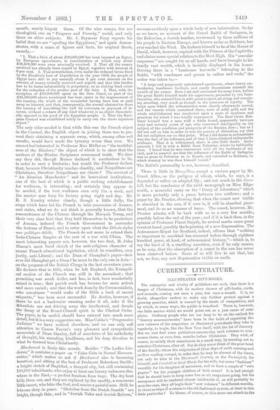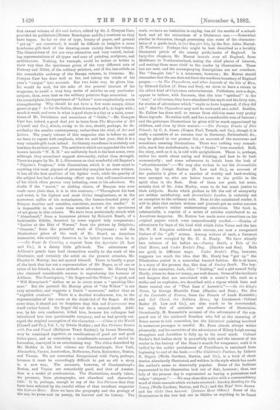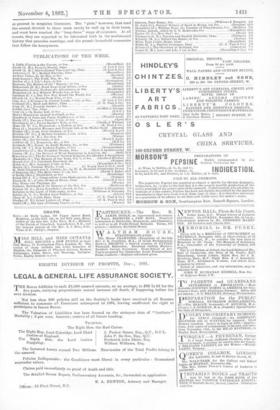CURRENT LITERATURE.
ILLUSTRATED GIFT-BOOKS.
The enterprise and rivalry of publishers are such, that there is a danger of Christmas, with its modern shower of gift-books, cards, and annuals, coming not once a year, but once a month. It is, no doubt, altogether useless to make any further protest against a growing practice, which is caused by the strain of competition, and by which, in many ways, the public is benefited. There is, however, one little matter which we would point out, as a just cause of com- plaint. Ordinary people who are too busy to be on the outlook for "literary announcements," have been in the habit of expecting the new volumes of the magazines or illustrated periodicals they take in regularly, to begin, like the New Year itself, with the 1st of January But we now find some publishers announcing such volumes to com- mence three, or even four, months before Christmas. They wish, of course, to satisfy their consciences in a small way, by seeming not to antedate Christmas, after all. Bat do they never think of the poor head of the family, whom the exigencies of these days of swift running and swifter reading compel, in order that he may be abreast of the times, not only to take in the Nineteenth, Century or the Fortnightly for himself, and Corn hill or Good Words for his wife, but some "fashions" monthly for his daughter of seventeen, and at least a couple of "own papers" for his younger children of both sexes? It is bad enough that he should have to keep some five or six magazines going, but his annoyance will be rendered almost intolerable if, as will probably be soon the case, they all begin their" now volumes" in different months. Is there no hope of a return to the old-fashioned system, at least in this little particular ? No blame, of course, on this score can attach to the first annual volume of Art and Letters, edited by Mr. J. Comyns Carr, provided its publishers (Messrs. Remington and Co.) continue as they have begun. So far as size of type, beauty of paper, and general " get-up " are concerned, it would be difficult to imagine a more handsome gift-book of the drawing-room variety than this volume. The illustrations of Art are very attractive and very varied, includ- ing representations of all types and eras of painting, sculpture, and architecture. Nothing, for example, could be better or bolder in their way than the specimens given of the very different arts of Fortuny and Millet, of the military painters, and of the bas-reliefs on the remarkable archway of the Stange column, in Cremona. Mr. Comyns Carr has done well so far, and taking the whole of his year's " output " into account. But two hints may be given him. He would do well, for the sake of the general interest of his magazine, to avoid a very long series of articles on any particular subject ; thus, even that on the military painters flags somewhat. In the second place, his department of "Letters" most emphatically needs strengthening. Why should he not have a few more essays, either grave or gay P As for the fiction, there is too much of it, to begin with ; much is weak, and even in what is good there is a tint or a taint, some- times of Mr. Svvinburne and sometimes of " Ouida."—Mr. Comyns Carr has, indeed, a good deal yet to learn from The Magazine of Art (Cassell and Co.), which, owing to its size, should, perhaps, be de- scribed as the smaller contemporary, rather than the rival, of Art and Letters. The yearly volume of this magazine also is before us, and we have to repeat with emphasis, what we said last year, that it is a very valuable gift-book indeed, Its literary excellence is certainly not Ices than its artistic grace. The articles to which are appended the well- known initials "W. E. H." are uniformly fresh in the best sense, even although they sometimes suggest strenuosity, rather than strength. There is a paper by Mr. R. L. Stevenson on that wonderful old Bagster's " Pilgrim's Progress," with illustrations, which is at least equal to anything this'inost piquant of present-day essayists has over written. It has all the best qualities of his lighter work, while the gravity of the subject has had a chastening effect upon that self-consciousness of his which often proves very irritating, even to his admirers. We doubt if the "secret," or abiding charm, of Banyan was ever made more plain than it is in this sentence,—" Throughout his best and wag, in his highest and most divine imaginations, as in the narrowest sallies of his sectarianism, the human-hearted piety of Bunyan touches and ennobles, convinces, accuses, the reader." It is impossible to do more than mention a few of the specimens of art given in this volume. We have been particularly struck with "Abandoned," from a humorous picture by Heinrich Ra.sch, of a fashionable fribble, deserted by some roguish lady companions ; "Luther at the Diet of Worms," from the picture by Delp6r6is ; " Canossa," from the powerful work of Cluysenaar ; and the illustrations given of the work of Mr. Beard, an American humourist, who certainly deserves to be better known than he is. —Sir Roger de Coverley, a reprint from the Spectator (S. Low and Co.), is a dainty little gift-book. The adventures of Addison's gentle hero lend themselves readily to the work of the illustrator, and certainly the artist on the present occasion, Mr. Charles O. Murray, has not spared himself, There is hardly a page of the book that has not a representation of Sir Roger, or of one or other of his friends, in some attitude or adventure, Mr. Murray has also obtained considerable success in reproducing the humour of Addison. The frontispiece, "Sir Roger and the Widow," is good, and "Will Honeycomb" strikes us as in every souse a "speaking like- ness." But the portrait Mr. Murray gives of "the Widow" is not very attractive, and suggests a Dutch " inevronw," rather than an " angelick creature." There is a decided woodenness, too, in the representation of the scene at the death-bed of Sir Roger. At the same time, it should not be forgotten that this sad denouement was itself rather forced, Sir Roger did not die a natural death. Addi- son, by his own confession, killed him, because his colleague had introduced him into questionable company, and so had grossly out- raged the original conception of the character.—Cities of the World (Cassell and Co.), Vol. I., by Edwin Hodder ; aud Sea Pictures Drawn with Pen and Pencil (Religious Tract Society), by James Macaulay, may be mentioned together, as combinations of good art and good letter-press, and as containing a considerable amount of useful in- formation, conveyed in an entertaining way. The cities described by Mr. Hodder in his first volume are Constantinople, New York, Alexandria, Venice, Amsterdam, Melbourne, Paris, Rotterdam, Boston, and Vienna. We are somewhat disappoieted with Paris, perhaps, because it must be exceedingly difficult to put so old a story in a new way. The accounts, however, of Constantinoplt • Boston, and Venice are remarkably good, and that of Amster- dam is a model of condensation. The illustrations, mostly taken, we presume, from photographs, are abundant and character- istic. It is, perhaps, enough to say of the Sea Pictures that they have been selected by the careful editor of that excellent magazine the Leisure Hour. Here we have the geography and the geology of the sea, its prose and its poetry, its harvest and its history. The work, we have no hesitation in saying, has all the merits of a school- book and all the attractions of a Christmas one.—Somewhat similar in character, though possessing also some of the character- istics of a guide-book, is Our Sea-girt Isle, by the Rev. Jabez Menet. (T. Woolmer.) Perhaps this might be best described as a lavishly illustrated pr6ois of the county guide-books of England. In forty-five chapters, Mr. Marrat travels over all England, from Middlesex to Northumberland, noting the chief places of interest, and making them more vivid to the reader by illustrations. These last are neat, and the accompanying descriptions are not overdone. The "Sea-girt Isla " is a misnomer, however ; Mr. Marrat should remember that the sea does not form the northern boundary of England proper.—In The Phynoderee, and other Legends of the Isle of Man, by Edward Callow (J. Dean and Son), we seem to have a return to the oldest kind of Christmas entertainment. Publishers, now-a.days, appear to believe, with Emerson, that the true "spiritual" is the " real ;" at all events, they have abandoned the myth and the fairy-tale, for stories of adventures which "ought to have happened, if they did not." But The Phynoclerse may well be reckoned as a relief. Besides, Mr. Callow has done well to rescue from oblivion some very pretty Manx legends. He writes well, and has a considerable vein of humour; and the grotesque illustrations he gives will be much appreciated by children, and even by their seniors.—The Foreign Freaks of Five Friends, by C. A. Jones. (Kegan Pan], Trench, and Co.), though it is really a narrative of an autumn tour in Germany, Switzerland, &c., may be placed in our present list, on account of the numerous and sometimes amusing illustrations. There was nothing very remark- able, much less melodramatic, in the " freaks " bore recorded. Still, the story, such as it is, is told with sprightliness. There is, perhaps, rather too much about eating and drinking, and how to do both economically ; and some references to hotels have the look of "advertisements."—We may also reckon in our list Journalistic London, by Joseph Hatton (S. Low and Co.), on account of the portraits it gives of a number of worthy and hard-working men amongst us, who are better known to the public in the spirit than in the flesh. Most of them are good, but some, notably that of Mr. John Morley, seem to do but scant justice to their subjects. Books which profess to lift the veil of anonymity are seldom satisfactory, and Journalistic London is certainly not an exception to the ordinary rule. Even to the uninitiated reader, it will be plain that certain writers and journals get an undue amount of the author's rather embarrassing attentions. The book is, substantially, a reprint of a series of articles contributed to an American magazine. Mr. Hatton has made some corrections on his original papers which were unquestionably needed.—Stories of adventures for boys of the kind with which Jules Verne and the late Mr. W. H. Kingston achieved such success, are now a recognised feature of the " gift " season. Among writers of such, a foremost, place is now occupied by Mr. G. A. Henty. We have already two volumes of his before us,—Facing Death, a Tale of the Coal Mines, and Under Drake's Flag. (Blackie and Son). Both are good, in different ways. Under Drake's Flag, however, suggests too much the idea that Mr. Henty has "got up" the Elizabethan period in a somewhat hurried fashion. He is at home. in a story of the present day, like that of Facing Death. The boy. hero of the narrative, Jack, alias "Bulldog," and a girl named Nally Hardy, whom he does not marry, are well drawn. Some of the incidents and dangers that are associated with a miner's life, such as a strike and an explosion, are described with a vigour which here and there remind, one of "That Lass o' Lowrie's."—In the King's Name, by George Manville Fenn (Blackio and Son) ; The Son of the Constable of France, from the Frei:Joh of Louis Rouaaelet ; and Red Cloud, the Solitary Sioux, by Lieutenant • Colonel Butler (S. Low and Co.), are also maoh to be commended, for easy flow of narrative and abundance of illustration, Occasionally, M. Rousselet's account of the adventures of the sup- posed son of the outlawed Bourbon who fell at the storming of Rome seems to halt somewhat, but the historical painting involved in numerous passages is careful. Mr. Fenn almost always writes pleasantly, and his narrative of the adventures of Hilary Leigh among smugglers and Jacobites is fully up to his usual mark. Colonel Butler's Red-Indian story is powerfully told, and the interest of the reader in the history of the Sioux's search for vengeance, until it is baffled by the nobler punishment of Providence, is sustained from beginning to end of the book.—The Children's Pastime, by Lisbeth E. El6guin (Wells Gardner, Darton, and Co.), is a book of short stories, abundantly illustrated, and written in the style whieh has made the author's name so deservedly popular. Some of the fashions represented in the illustration look out of date, however ; thus, one lady of the present day is represented as having a portentous and vulgar "chignon."—We may close this notice with a commendatory word of three annuals which we have received : Sunday Reading for the Young (Wells Gardner, Herten, and Co.); and the Boys' Own Annua and the Girls' Own Annual. (Leisure Hour Oflioe.) Some of the illustrations in the two last are as lifelike as anything to be found
at present in magazine literature. The "girls," however, that road the annual devoted to them must surely be well up in their teens, and must have reached the "long-dress" stage of existence. At all events, they are expected to be interested both in the sentimental history that precedes marriage, and the prosaic household economics that follow the honeymoon.




































 Previous page
Previous page